Properly storing your golf cart for winter is essential to ensure its longevity and performance. Cold temperatures can impact battery life and overall functionality. By following best practices for cleaning, maintenance, and storage, you can protect your golf cart from winter damage and keep it ready for use come spring.
What Are the Essential Steps for Winterizing a Golf Cart?
The essential steps for winterizing a golf cart include:
- Clean the Cart: Thoroughly wash and dry the exterior to remove dirt and debris.
- Charge the Battery: Ensure the battery is fully charged before storage.
- Disconnect the Battery: If applicable, disconnect the battery to prevent drainage.
- Store Indoors: Find a dry, sheltered location to protect it from harsh weather.
Chart: Steps for Winterizing Your Golf Cart
| Step | Description |
|---|---|
| Clean the Cart | Wash exterior and dry thoroughly |
| Charge the Battery | Fully charge before storage |
| Disconnect the Battery | Prevents drainage during storage |
| Store Indoors | Protects from cold, moisture, and snow |
How Should You Clean Your Golf Cart Before Storage?
Cleaning your golf cart involves:
- Washing: Use soap and water to clean all surfaces, including tires and undercarriage.
- Drying: Ensure all areas are completely dry to prevent rust or corrosion.
- Inspecting: Check for any signs of damage or wear that need repair before storage.
Regular cleaning helps maintain appearance and functionality.
Why Is It Important to Store Your Golf Cart Indoors?
Storing your golf cart indoors protects it from extreme weather conditions such as snow, ice, and freezing temperatures. Indoor storage also prevents moisture buildup that can lead to rust and corrosion, ensuring that your cart remains in optimal condition throughout winter.
What Preparations Should Be Made Before Storing a Golf Cart?
Before storing a golf cart, consider these preparations:
- Check Tire Pressure: Inflate tires to recommended levels to avoid flat spots.
- Add Fuel Stabilizer: For gas-powered carts, adding fuel stabilizer prevents fuel degradation.
- Remove Perishables: Clear out any food or drinks that could spoil or attract pests.
These steps help ensure that your golf cart is ready for use when spring arrives.
How Can You Maintain the Battery During Winter Storage?
To maintain the battery during winter:
- Charge Regularly: Check and charge every month if stored long-term.
- Use a Battery Tender: This device keeps batteries charged without overcharging them.
- Store in a Warm Place: Keep batteries in a temperature-controlled environment if possible.
Regular maintenance helps prolong battery life and ensures reliable performance.
What Are the Signs of Battery Degradation in Cold Weather?
Signs of battery degradation include:
- Decreased Capacity: Noticeable drop in available power.
- Swelling or Leakage: Physical changes indicating potential failure.
- Increased Self-Discharge Rate: Rapid loss of charge when not in use.
If any of these signs are observed, it may be necessary to assess the battery’s health more closely or consider replacement.
How Do You Protect Your Golf Cart From Cold Weather?
To protect your golf cart from cold weather:
- Use a Quality Cover: Invest in a durable cover designed specifically for golf carts.
- Park in Sheltered Areas: If indoors isn’t an option, choose covered parking areas.
- Insulate Exposed Parts: Use insulation materials on sensitive components like batteries.
These measures help mitigate risks associated with cold temperatures.
What Materials Are Effective for Covering and Insulating a Golf Cart?
Effective materials include:
- Waterproof Covers: Protect against moisture and debris while allowing airflow.
- Thermal Blankets: Insulate sensitive components like batteries from extreme cold.
- Foam Insulation: Lightweight material that retains heat effectively.
Using these materials enhances protection during winter storage.
Why Is Proper Tire Maintenance Important During Winter Storage?
Proper tire maintenance is crucial because cold temperatures can cause tire pressure to drop, leading to flat spots or damage over time. Ensuring tires are inflated to recommended levels helps maintain their shape and performance when spring arrives.Chart: Tire Pressure Recommendations
| Temperature (°F) | Recommended Pressure (PSI) |
|---|---|
| 32 | 20 |
| 0 | 18 |
| -20 | 16 |
Tips for Battery Wholesale Buyers
When considering wholesale purchases or OEM orders for lithium-ion batteries:
- Choose Reliable Manufacturers: Partner with established manufacturers like Redway Battery, known for quality and reliability.
- Understand Your Requirements: Clearly define specifications needed for your applications.
- Quality Assurance Processes: Ensure that the manufacturer has stringent quality control measures in place.
Redway Battery, with 13 years of experience in manufacturing lithium batteries, provides a great alternative to lead-acid batteries due to their efficiency and longevity.
Redway Battery Expert Insight
“Properly preparing your golf cart for winter storage is essential not just for its longevity but also for ensuring reliable performance when you need it,” states an expert from Redway Battery. “By following best practices such as maintaining battery health and using protective coverings, users can significantly enhance their vehicle’s lifespan.”
FAQ Section
- Can I leave my golf cart outside during winter?
It’s not recommended; always store it indoors or under protective cover to prevent damage from cold weather. - How often should I check my golf cart during winter storage?
Regular checks every month are advisable to monitor battery health and overall condition. - What should I do if my battery shows signs of degradation?
Consider replacing it if you notice significant capacity loss or physical damage; consult with a professional if unsure.




